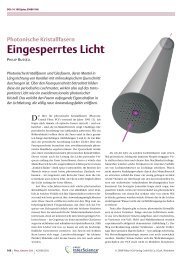Diploma thesis
Diploma thesis
Diploma thesis
Create successful ePaper yourself
Turn your PDF publications into a flip-book with our unique Google optimized e-Paper software.
Figure 3.35: Unfiltered JSA, JSA + filter function, filtered JSA<br />
of heavy photon loss.<br />
In order to quantify the performance of this method we choose a common KTP<br />
waveguide chip. In KTP most of the nonlinear indices dij are vanishing [22], with<br />
the exception of:<br />
❏ d15 = 3.7 pm/V<br />
❏ d24 = 1.9 pm/V<br />
❏ d31 = 3.7 pm/V<br />
❏ d32 = 2.2 pm/V<br />
❏ d33 = 14.6 pm/V<br />
. Only a few processes remain:<br />
⎛<br />
⎝<br />
Px<br />
Py<br />
Pz<br />
⎞ ⎛<br />
0<br />
⎠ = ɛ0 ⎝ 0<br />
3.7<br />
0<br />
0<br />
2.2<br />
0<br />
0<br />
14.6<br />
0<br />
1.9<br />
0<br />
3.7<br />
0<br />
0<br />
⎞<br />
0<br />
0⎠<br />
·<br />
0<br />
pm<br />
V ·<br />
⎜ ⎟<br />
⎜ ⎟<br />
⎜ ⎟<br />
⎜ ⎟<br />
⎜<br />
⎜2EyEz<br />
⎟<br />
⎝2EzEx<br />
⎠<br />
2ExEy<br />
⎛<br />
(Ex) 2<br />
(Ey) 2<br />
(Ez) 2<br />
Five different processes are available in KTP, the strongest is a type-I downconversion<br />
process with z-polarized pump, signal and idler fields. However we have<br />
to separate the signal and idler photons after they leave the crystal and therefore<br />
must excite a type-II downconversion process, despite the smaller nonlinearities as<br />
opposed to type-I downconversion.<br />
We choose a waveguide chip with parameters depicted in Table 3.3. The chip is<br />
periodically poled in such a way that it fulfills phasematching conditions at λs,i =<br />
800 nm. KTP as a material is very common and crystals with these parameters are<br />
often applied in experiments investigating entanglement properties.<br />
⎞<br />
27



